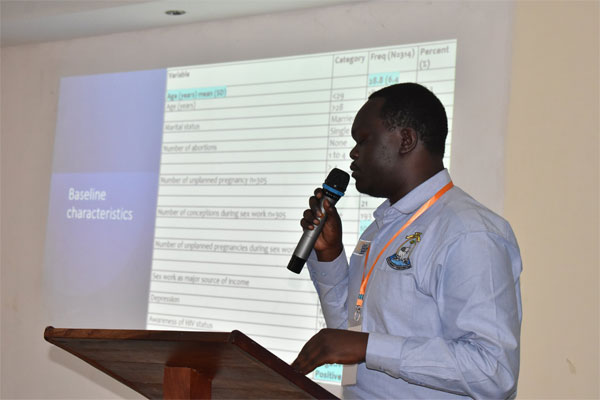
Gulu, Uganda | THE INDEPENDENT | Over a third of commercial sex workers in Gulu City are married and staying with their partners, a study conducted by Gulu and Lira Universities has revealed. The principal investigator of the research, Dr. Felix Bongomin, who is also a lecturer in the Faculty of Medicine at Gulu University, shared the findings during the inaugural Gulu and Lira Universities Annual Scientific Symposium held at Bomah Hotel in Gulu City on Friday.
Dr. Bongomin elaborated that the study, conducted between February and March of this year, engaged 314 female commercial sex workers from 15 hotspots within Gulu City. The research delved into the use of dual contraception among these women, with funding provided by the Centre for International Reproductive Health Training (CIRHT) through a research seeds grant for junior researchers.
The research aimed to understand the underlying factors and circumstances contributing to the involvement of married women in commercial sex work. Dr. Bongomin explained that the number of female commercial sex workers in Gulu City increased during the COVID-19 lockdown, aimed at curbing the disease’s spread.
The study identified diverse motivations for married women’s participation in commercial sex work, including the economic fallout caused by COVID-19, leading to unemployment, financial struggles, loss of regular employment, preferential treatment of sex workers for relief aid, and the lucrative nature of the business.
Other contributing factors cited were idleness, broken relationships, experiences of sexual violence like rape, long-distance relationships, abusive partners, and a lack of support from male partners.
Commercial sex workers were reported to engage in this trade discreetly, leaving their marital homes without their male partners’ knowledge, all in pursuit of financial gain. The respondents in the study ranged in age from 15 to 49 years, and a prominent finding was the high adoption of dual contraceptives among them.
Among the 314 participants, 208 were found to consistently use condoms alongside another modern method of family planning, while over half were observed to use intrauterine devices, signaling a cautious approach to unplanned pregnancies.
Despite responsible contraceptive behavior, the research noted instances where some female sex workers engaged in unprotected intercourse due to higher financial incentives, as clients paid more for condomless encounters. This behavior, while financially rewarding, exposed them to increased risks of sexually transmitted infections and diseases (STIs and STDs).
Abstract presentations continue at the First Gulu and Lira Universities Scientific Symposium happening at Bomah Hotel City. Dr Alobo Gasthony,Dr Opee Jimmy, Ms. Auma Anna Grace, and Dr. Alobo Jackie are the panelists for these abstracts.@CIRHT @LIRA_UNIVERSITY pic.twitter.com/DLYpGVzUPt
— Gulu University (@GuluVarsity) August 25, 2023
An encouraging aspect was that 75% of these workers tested HIV negative, and many practiced preventive measures like antiretroviral therapy (ARV), safeguarding themselves from HIV transmission. However, the study also highlighted significant barriers hindering access to sexual and reproductive health services for female commercial sex workers.
Stigma, low self-esteem, and negative attitudes from healthcare professionals were among the key challenges noted. Another study within the same framework, presented by Anna Grace Auma of Lira University, uncovered a concerning pattern of repeated teenage pregnancies among young girls.
The research indicated that some teenagers experienced up to three pregnancies at a tender age, underscoring the magnitude of unwanted pregnancies and the subsequent health burdens, including abortions, maternal mortality, infections, and disabilities.
Auma also pointed to the limited adoption of vasectomy among men, attributing this to knowledge gaps, misconceptions, cultural and religious beliefs, and societal influences. The symposium also unveiled additional findings, such as the utilization of family healthcare services among health workers, which stood at 70.6%.
Dr. Francis Pebalo Pebolo, the Head of the Research Organizing Committee, stated that the research initiative covered various aspects, including commercial sex work, post-abortion care, sexual and reproductive health, and family planning. Siyane Aniley (Ph.D.) from CIRHT emphasized the organization’s mission to reduce maternal mortality through enhanced education for medical students and support for curriculum development within the health system.
She called for policymakers to collaborate in minimizing maternal deaths while promoting education on healthy sexual and reproductive lives.
CIRHT’s support extended to the establishment of lecture production studios, simulation laboratories, and teleconferencing facilities in Lira and Gulu Universities through the allocation of 48 seed grants.
****
URN
 The Independent Uganda: You get the Truth we Pay the Price
The Independent Uganda: You get the Truth we Pay the Price


